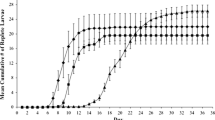Abstract
Ticks are subject to various environmental constrains, such as dehydration, desiccation and long-waiting for hosts to attach. These factors are crucial for tick survival in the environment. Ticks have developed physiological mechanisms and/or strategies that allow adaptability and survival in the environment in which they live, such as spiracle control and cyclical or discontinuous gas exchanges. However, details of gas exchange profile have been reported only in a few tick species in the past. The present study aims to identify and describe respiratory gas exchange patterns in a tropical population of the brown dog tick Rhipicephalus sanguineus sensu lato and effects of blood feeding. Adult female ticks were fed on rabbit hosts. Partially fed (4 to 6 days) and completely fed (> 9 days) ticks were collected daily during feeding, weighed and subjected to CO2 emission measurement at 25 °C using flow-through respirometry. Unfed adult females showed a well-defined periodical burst of CO2 emissions, followed by short periods of low-emission intercepts. The fed groups had drastic changes in respiratory profiles with semi-engorged females showing a high-intensity respiratory pattern alternating between continuous and discontinuous and the engorged females showing a continuous respiratory pattern with high frequency and intensity. The findings from this study contribute to a better understanding of the respiratory physiological process of a tropical population of the dog tick, which may help future investigations on other biological aspects of this ectoparasite and development of control measures.

Similar content being viewed by others
References
Barros-Battesti DM, Arzua M, Bechara GH. (2006) Carrapatos de Importância Médico-Veterinária da Região Neotropical: Um Guia Ilustrado Para Identificação de Espécies. São Paulo: Vox/ICTTD-3/Butantan, 5-7
Chown SL, Gibbs AG, Hy SK, Ky CJ, Ly JR, Marais E (2006) Discontinuous gas exchange in insects: a clarification of hypotheses and approaches. Physiol Biochem Zool 79:333–343
Estrada-Peña A, Quíez J, Sánchez Acedo C (2004) Species composition, distribution, and ecological preferences of the ticks of grazing sheep in north-central Spain. Med Vet Entomol 18(2):123–133
Fielden LJ, Ducan FD (2013) Respiratory system: structure and function. In: Sonenshine DE, Roe RM (eds) Biology of ticks, vol 1, 2nd edn. Oxford University Press, New York, pp 240–257
Fielden LJ, Lighton JRB (1996) Effects of water stress and relative humidity on ventilation in the tick Dermacentor andersoni (Acari: Ixodidae). Physiol Zool 69:599–617
Fielden LJ, Duncan FD, Lighton JRB, Rechav Y (1993) Ventilation in the adults of Amblyomma hebraeum and A. marmoreum (Acarina, Ixodidae), vectors of heartwater in southern Africa. Rev Elev Med Vet Pays Trop 46:335–338
Fielden LJ, Jones RM, Goldberg M, Rechav Y (1999) Feeding and respiratory gas exchange in the American dog tick, Dermacentor variabilis. J Insect Physiol 45:297–304
Hetz SK, Bradley TJ (2005) Insects breathe discontinuously to avoid oxygen toxicity. Nature 433(7025):516–519
Labruna MB, Gerardi M, Krawczak FS, Moraes-Filho J (2017) Comparative biology of the tropical and temperate species of Rhipicephalus sanguineus sensu lato (Acari: Ixodidae) under different laboratory conditions. Ticks Tick-Borne Dis 8:146–156
Lighton JRB (1996) Discontinuous gas exchange in insects. Ann Rev Entomol 41:309–324
Lighton JRB (1998) Notes from underground: towards ultimate hypotheses of cyclic, discontinuous gas-exchange in tracheate arthropods. Am Zool 38:483–491
Lighton JR, Fielden LJ, Rechav YIGAL (1993) Discontinuous ventilation in a non-insect, the tick Amblyomma marmoreum (Acari, Ixodidae): characterization and metabolic modulation. J Exp Biol 180:229–245
Moraes-Filho J, Krawczak FS, Costa FB, Soares JF, Labruna MB (2015) Comparative evaluation of the vector competence of four South American populations of the Rhipicephalus sanguineus group for the bacterium Ehrlichia canis, the agent of canine monocytic ehrlichiosis. PLoS ONE 10(9):e0139386
Nava S, Estrada-Peña A, Petney T, Beati L, Labruna MB, Szabó MP, Venzal JM, Mastropaolo M, Mangold AJ, Guglielmone AA (2015) The taxonomic status of Rhipicephalus sanguineus (Latreille, 1806). Vet Parasitol 208:2–8
Needham GR, Teel PD (1991) Off-host physiological ecology of ixodid ticks. Ann Rev Entomol 36:659–681
Sonenshine DE, Roe RM (eds) (2013) Biology of ticks, vol 1, 2nd edn. Oxford University Press, New York, p 560
Valim JR, Rangel CP, Baêta BA, Ribeiro CC, Cordeiro MD, Teixeira RC, Cepeda PB, Fonseca AH (2017) Using plastic tips in artificial feeding of Rhipicephalus sanguineus sensu lato (Acari: Ixodidae) females. Rev Bras Parasitol Vet 26(1):110–114
Walker JB, Keirans JE, Horak IG (2000) The genus Rhipicephalus (Acari, Ixodidae): a guide to the brown ticks of the world. Cambridge University Press, Cambridge, p 643
Zheng H, Li AY, Fielden LJ, Liu J, Seshu J, León AAP (2013) Effects of permethrin and amitraz on gas exchange and water loss in unfed adult females of Amblyomma americanum (Acari: Ixodidae). Pest Biochem Physiol 107(2):153–159
Zheng H, Li AY, Teel PD, León AAP, Seshu J, Liu J (2015) Biological and physiological characterization of in vitro blood feeding in nymph and adult stages of Ornithodoros turicata (Acari: Argasidae). J Insect Physiol 75:73–79
Acknowledgements
This research was supported through grants from FAPEMA (Maranhão State Research Foundation, Brazil) and CAPES (Coordination for the Improvement of Higher Education Personnel, Brazil). G.A. Landulfo and N.C.S. Silva received a post doc fellowship from CAPES, and A.S. Lima and T.L. Vale received an PhD scholarship from FAPEMA. The authors would also like to thank CNPq for a fellowship to L.M. Costa-Júnior.
Author information
Authors and Affiliations
Corresponding author
Ethics declarations
Conflict of interest
The authors declare that they have no conflict of interests.
Additional information
Publisher's Note
Springer Nature remains neutral with regard to jurisdictional claims in published maps and institutional affiliations.
This article reports the results of research only. Mention of a proprietary product does not constitute an endorsement or a recommendation by the USDA for its use. The USDA is an equal opportunity provider and employer.
Rights and permissions
About this article
Cite this article
Landulfo, G.A., Li, A.Y., Lima, A.S. et al. Feeding and respiratory gas exchange of Rhipicephalus sanguineus sensu lato (Acari: Ixodidae). Exp Appl Acarol 78, 173–179 (2019). https://doi.org/10.1007/s10493-019-00383-3
Received:
Accepted:
Published:
Issue Date:
DOI: https://doi.org/10.1007/s10493-019-00383-3




